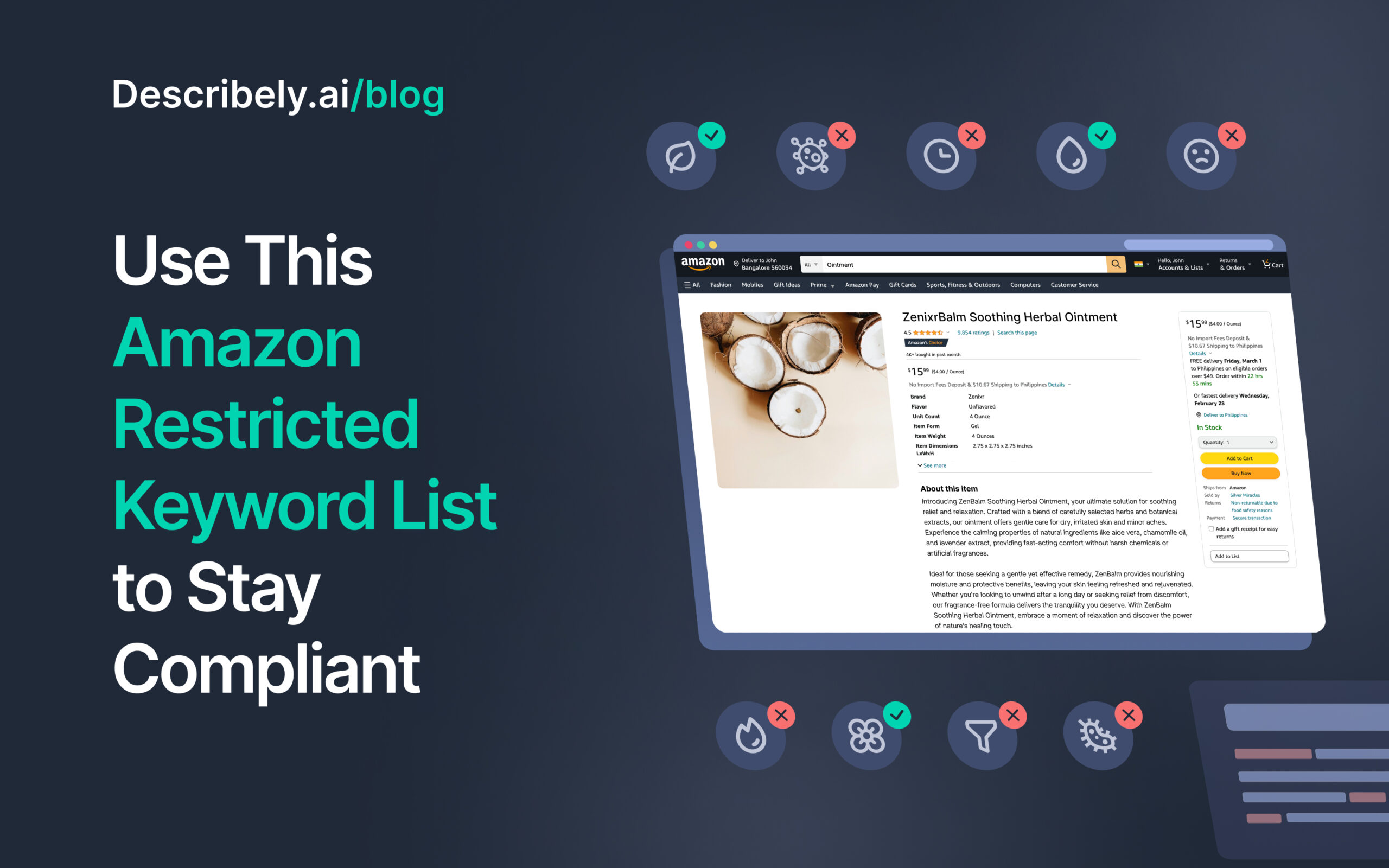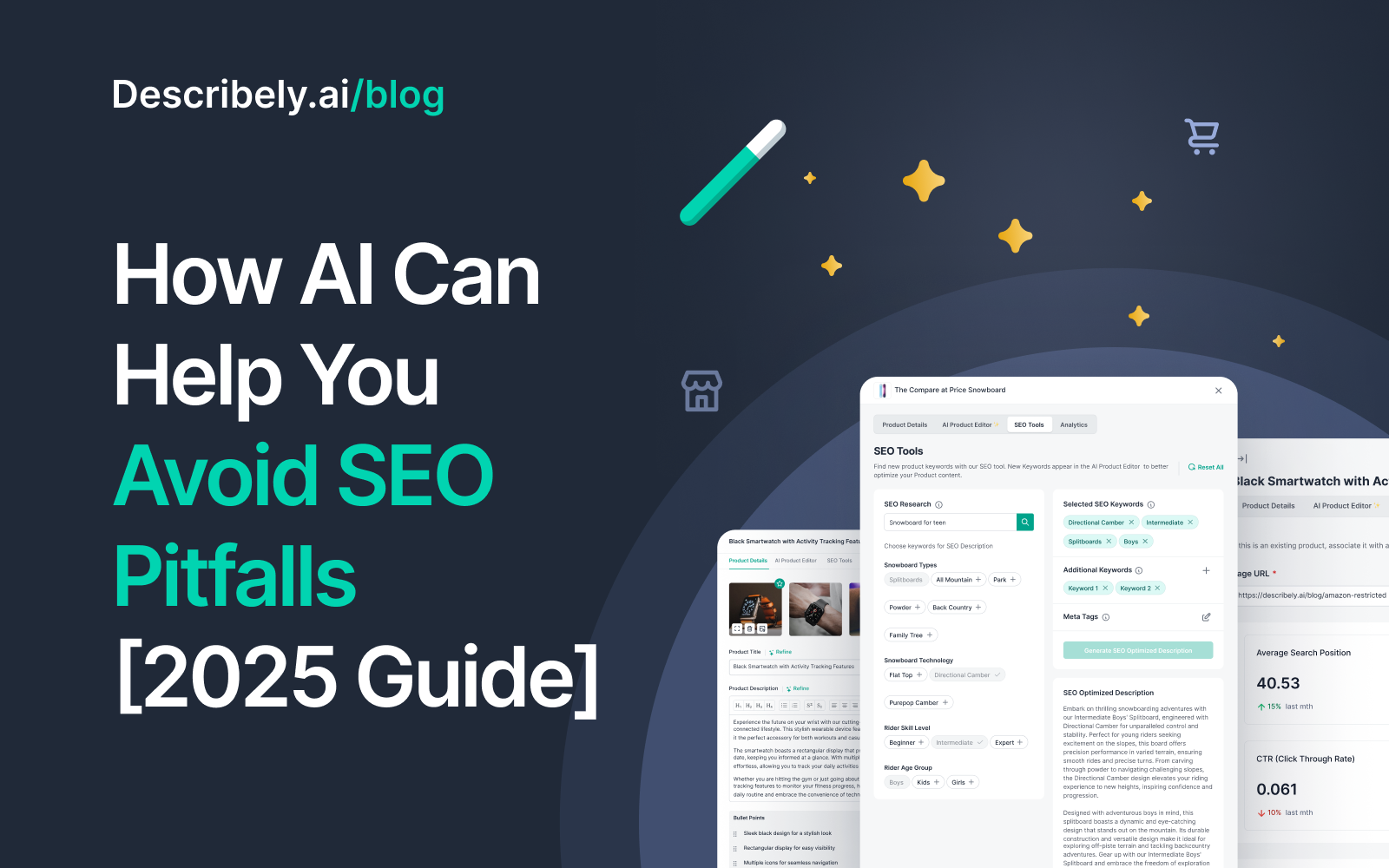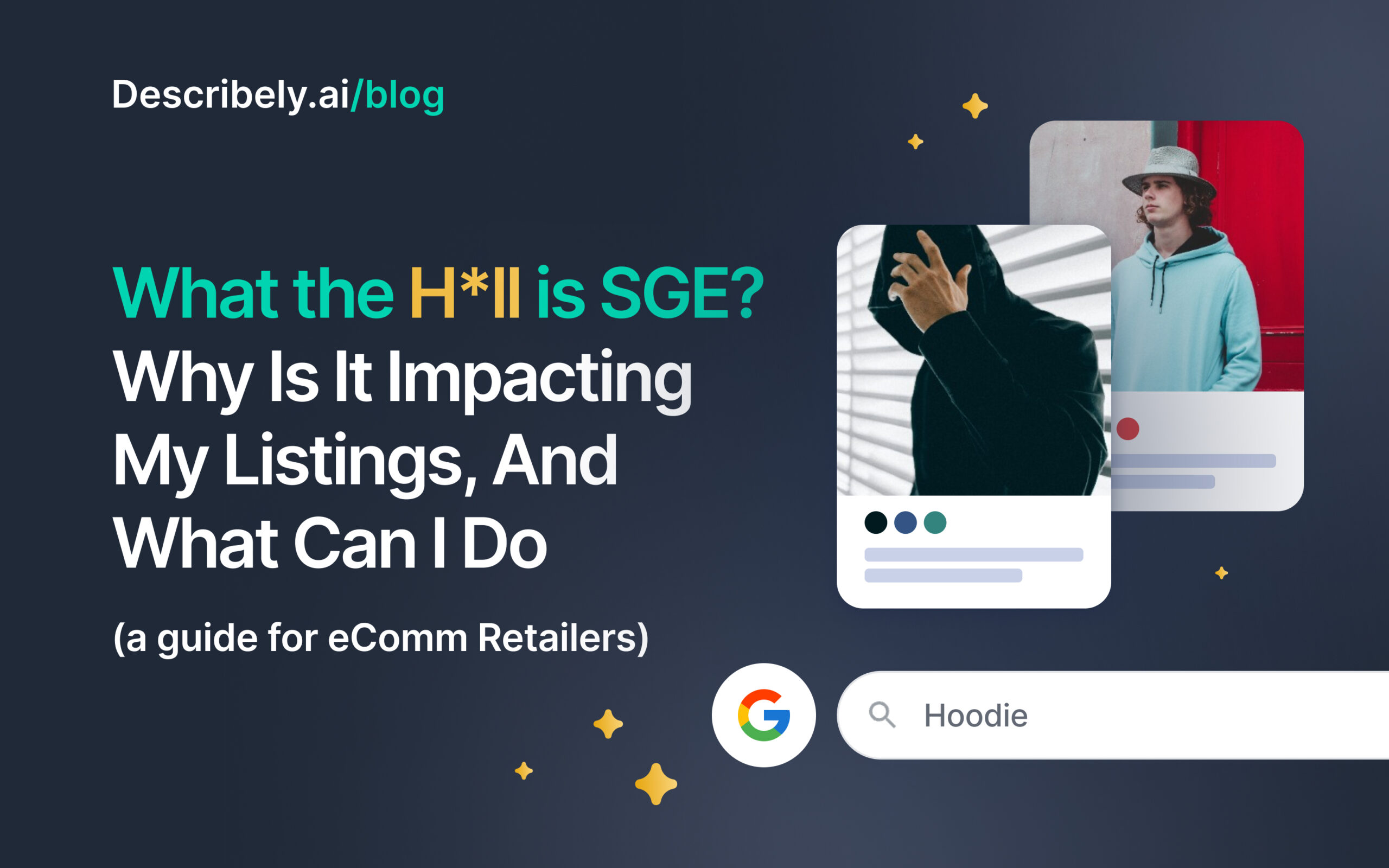
What the H*ll is SGE? Why Is It Impacting My Listings, And What Can I Do (A guide for eComm Retailers)
In the past few years, almost every tool or app has started incorporating AI into their workflow. Google’s no different.
With its SGE (Search Generative Experience) update, we’re bound to browse the SERPs a lot less and converse with Google a whole lot more.
This is good news if you’re a user who’s on the internet for a quick answer. Not so much if you’re an eComm (or SEO) person vying for people’s attention on the SERPs.
It’s even worse news if you’re an eCommerce retailer who sells a majority of your products through organic visitors on your site, as this SGE update can deeply tank your search traffic, more so once it goes from being a beta feature to a permanent feature.
Dive in to find out more about how the SGE feature can impact your product listings and what you can do to get noticed by SGE, Co-Pilot, and the like.
TLDR Pointers:
- AI tools like SGE and Co-Pilot are favoring product descriptions over product listings in their search results.
- They’re also recommending products based on search intent so you need to be more specific about product qualities and attributes in your descriptions.
- To get noticed, experts are recommending optimizing product descriptions (tools like Describely.ai can help) and investing in a surround sound strategy.
What’s the SGE update, and how does it impact your product?
The SGE update is Google’s way of using generative AI to produce quick answers for its customers. Think of it as Google’s own ChatGPT.
Presently (aka in 2024), the feature is still in its testing phase, but it’s bound to have a full-scale global rollout soon. Just for reference, here’s how the feature responds if you input non-branded keywords like ‘women black jeans’.

Alternatively, if you look for branded keywords like “North Face Hoodie,” you’re bound to get results like these:

While we can’t deny that this feature has an excellent UX, it also has a key disadvantage: There are only a handful of recommendations that make it to SGE, and you have to fight to make it into the list.
This obviously becomes a huge setback if you’re an established retailer who also has other stores selling their own products (or product knock-offs) or if you’re someone who operates in a niche where the top spots on the SERPs for a keyword have already been taken.
Alyeda Solis, an eCommerce SEO consultant, shared on social media:
“If you’re in eCommerce, a likely consequence of Google’s SGE is established brand retailers PLPs (product listings pages) will lose organic search traffic that *won’t* likely only go to their own PDPs (product detail pages), but also to other online stores offering the product. This is traffic that they pretty much owned, going to the brand retail PLP.”
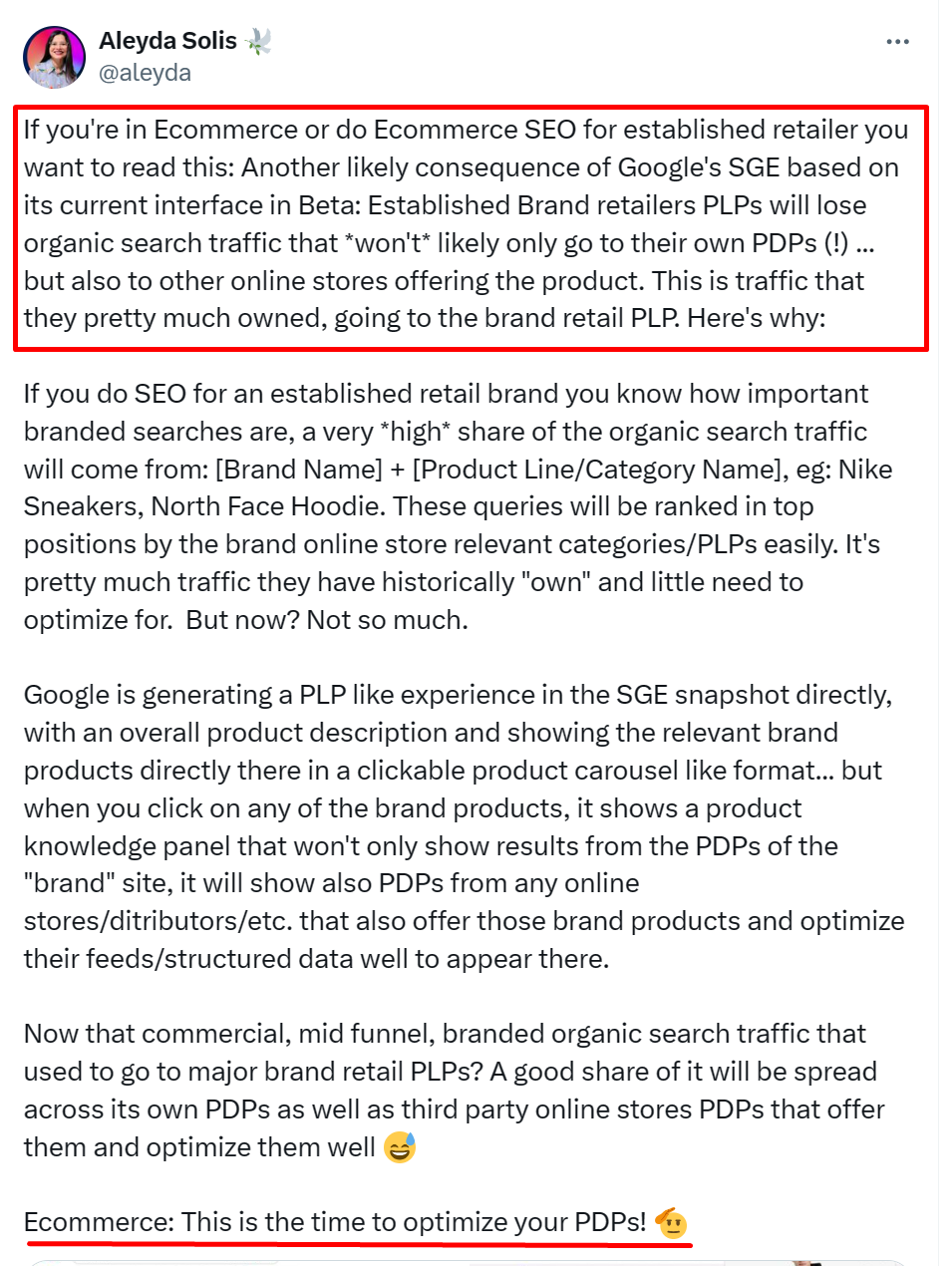
The issue is clear here—-SGE does not care about who owns the product or who has the best deals because it’s no longer capitalizing on product listings (or PLPs).
Rather, it only cares for who has the most optimized product descriptions (or PDPs), which it can further use to improve the search experience for its user and provide them with recommendations based on their search intent.
This is why a common advice most SEO experts are sharing is to optimize your PDPs, including your descriptions, images, and everything else in between.

While one might think that this is a Google-only issue, Co-Pilot (Bing’s AI), which is akin to SGE, also follows the same methodology for getting their search results.
Just as an example to prove our point, we inserted the search term “Elle Saab perfumes” in Co-Pilot, and these are the sources it derived results from (the first and third sources are top-ranking listicles that provide plenty of product information and are optimized for the branded keywords).

Other potential impacts of SGE and Co-Pilot on eCommerce stores
We previously saw how SGE and Co-Pilot get product information not only from product description pages, but also from top-ranking listicles that contain plenty of product content. This is true whether you look up branded or unbranded keywords.
Safe to say, if you are a home-grown brand retailer, and you’re competing with eCommerce giants who have an established presence on SERPs and have plenty of optimized product listings, then one way for you to stand out would be to partner with affiliate sites who are currently on the top spots of the SERPs to get organic traffic from SGE while also optimizing your own product listings (some experts are calling it the surround sound strategy).


However, there might be some potential disadvantages of the surround sound strategy, too, such as:
- Having a well-established affiliate program costs lots of money, and you might need to either inflate your marketing budget or prioritize which marketing activities or products are worth focusing on.
- You will need to qualify as an affiliate, and authoritative brands that usually take the top spots on SERPs (such as Bazaar, Variety, Healthline, etc.) have strict rules and guidelines.
- There’s less transparency involved—while most websites have a disclaimer notice that certain products are affiliates and they may earn a small commission from it, SGE/Co-Pilot don’t mention any notices like those, which might lead to biased purchases.
Aside from this, another thing to consider is that SGE derives most of its product data/recommendations from Google’s Shopping Graph, which is a more real-time experience that keeps track of all product inventory, pricing, vendors, and availability.
This also means that once SGE recommends a product, you’ll be competing with multiple sellers for the same sale at the same time. Due to the nature of this, we predict that SGE will cause a race-to-the-bottom kind of situation, wherein retailers would not be competing on factors like quality or sustainability, but rather mostly on price.
While SGE is doing its best to only show recommendations that match search intent (and only list sellers that have optimized their product descriptions), it’s certainly doing no favors to the retailer as your customer would be spoilt for choice without having to put the effort to even scroll the search results or manually compare any two products as all the busywork would already be done for them.
On the other hand, to make the customer experience more enjoyable and to be recommended by SGE, retailers will also need to invest effort (and money) in product content, SEO, granular product shots, reviews, offers, etc.
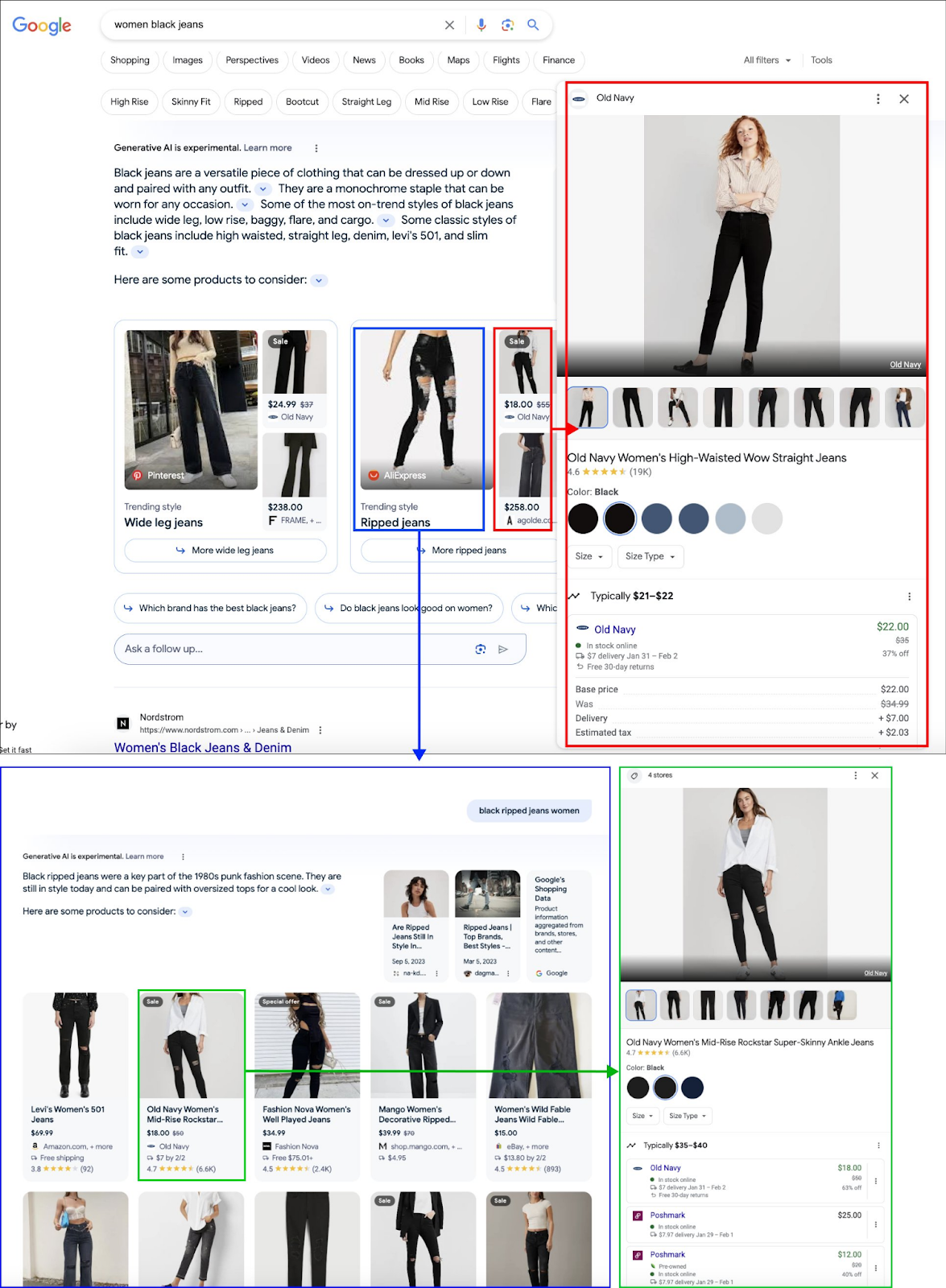
What can you do to get noticed by SGE, Co-Pilot, and the like?
The quickest way to do this is to add your product into Google and Bing’s training data. In fact, experts happen to agree with this practice, too.
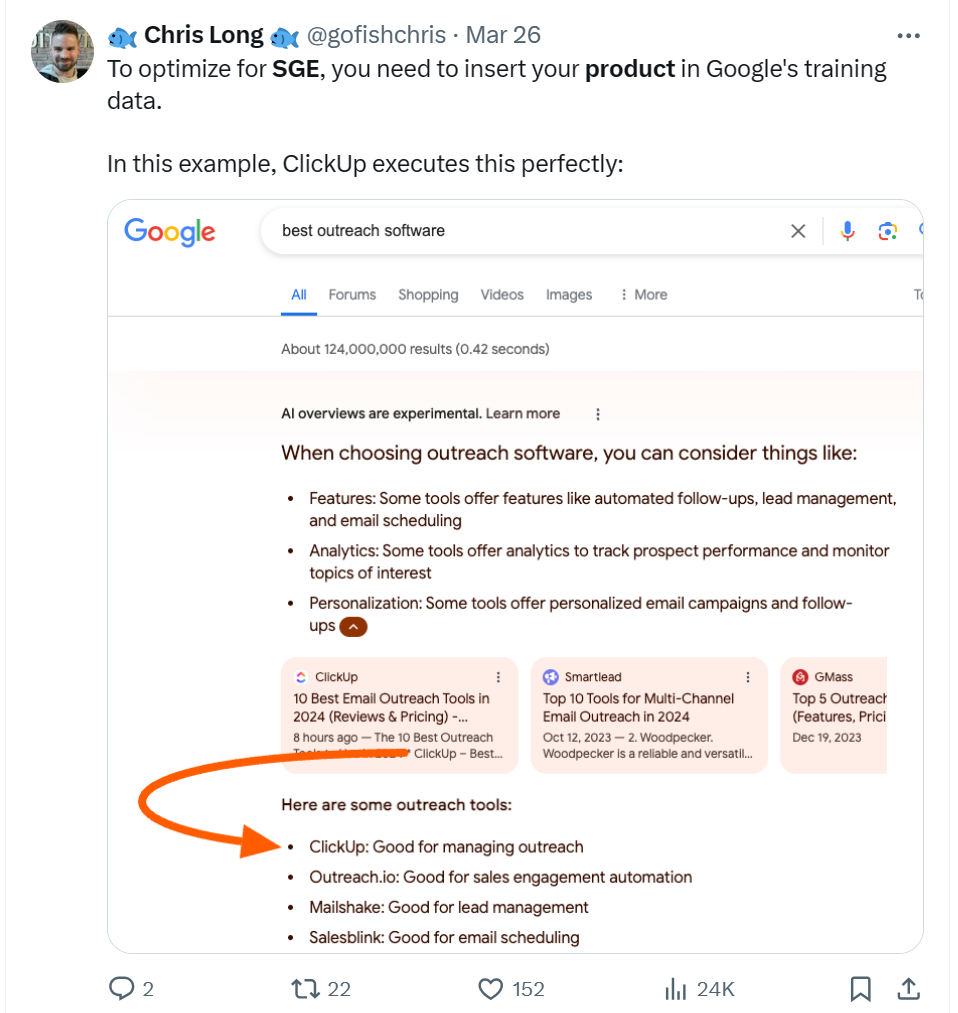
But how do you get your product into their training data, you ask? Optimizing your product listings seems to be the only answer.
Since SGE/Co-Pilot have conversational style capabilities and are best at matching product recommendations with search intent, you’ll really need to go a step forward to explain your product’s capabilities and benefits, and build the overall atmosphere in your product listings to tell your customers exactly how they’d feel after wearing it.
For example, if you sell a dress, consider potential buyer questions like:
- Does it have pockets?
- Which season can it be worn in (summer or spring)?
- Where do you recommend wearing it (casual brunch vs. cocktail dinner)?
- What type of style and hemming does it have?
We had Kayla Heesseltine, our Senior Account Executive, and Wade Cline, GM and Head of Sales at TrustSpot host a webinar some time back, and they addressed topics like how to enhance product listings and build trust with them—-you can check out their interview insights here if you’d like.
Another interesting thing to note is that some companies have also started using UGC (user-generated content) in their listings page to show customers how their products look like once in use:

However, aside from just adding the necessary product information in your descriptions, you’ll also need to follow SEO best practices, vis-a-vis integrating keywords, adding alt text to images, structuring and formatting content well, etc.
Aleyda Solis also has an SEO checklist for eCommerce product pages, which you can check out here.
We’d also highly recommend using the surround sound strategy which experts are recommending, especially if you have the budget for it. (Both experts—Maeva Cifuentes and Usman Akram—-said they’d spoken to others who saw a positive outcome on ROI with this strategy.)
How Describely can help with optimizing your product pages to be discovered in SGE?
An overlying advice amongst all experts seems to be to invest in your product listings and optimize your product descriptions.
To do this, you can either invest in hiring writers who specialize in creating/enriching product descriptions, or you can invest in an AI tool that will write, edit, and update product descriptions on your behalf.
While both options are credible, the former might end up costing you good money as hiring top-quality talent is not cheap. However, if you leverage AI tools that are specially trained with eCommerce data, you can create/enhance your product descriptions in bulk.
For example, a tool like Describely allows you to:
- Create, edit, and update product descriptions in bulk;
- Enhance product attributes and fill gaps in your content.
- Maintain your tone of voice by adjusting the AI rulesets.
- Optimize your product descriptions with SEO best practices.
What’s more is that its pricing is adjustable according to your product needs, and you can check out its capabilities by opting for a free trial. We’ve helped brands like Target, Marshalls, HOM Furniture, and more, and we can help you out, too.
Learn how Describely can help you create content that sells more and ranks higher. Get started now!
Written By: Juwaria Merchant
 Juwaria Merchant is a freelance writer for SaaS and Marketing brands who specializes in long-form content. Backed with 4+ years of experience, she helps brands create valuable content in the age of AI. In her free time, you can catch her reading her favorite books or geeking about the latest trends online.
Juwaria Merchant is a freelance writer for SaaS and Marketing brands who specializes in long-form content. Backed with 4+ years of experience, she helps brands create valuable content in the age of AI. In her free time, you can catch her reading her favorite books or geeking about the latest trends online.


